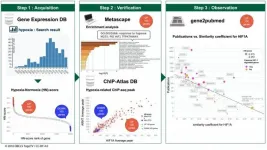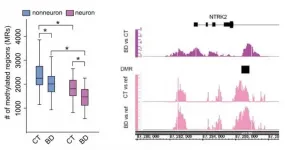New study presents tip-induced nano-engineering of strain, bandgap, and exciton funneling in 2D semiconductors
2021-06-09
(Press-News.org) A research team, led by Professor Kyoung-Duck Park in the Department of Physics at UNIST has succeeded in investigating and controlling the physical properties of naturally-formed nanoscale wrinkles in two-dimensional (2D) semiconductors. This is thanks to their previously-developed hyperspectral adaptive tip-enhanced photoluminescence (a-TEPL) spectroscopy. This will be a major step forward in developing paper-thin, ultra-flexible displays.
Wrinkles are an inevitable structural deformation in 2D semiconductor materials, which gives rise to spatial heterogeneity in material properties, according to the research team. Such structural deformation has long been considered one of the top technical challenges in semiconductor manufacturing, as this would harm the uniformity in structural, electrical, and optical properties of semiconductors. Besides, because the size of these wrinkles is quite small, the accurate analysis of their structural, optical, and excitonic properties has been impossible with conventional spectroscopic tools. "Recent strain-engineering approaches have enabled to tune of some of these properties, yet there has been no attempt to control the induced strain of naturally-formed nanoscale wrinkles, while simultaneously investigating their modified nano-optical properties," noted the research team.
In this study, the research team presented a hyperspectral TEPL nano-imaging approach, combined with nano-optomechanical strain control, to investigate and control the nano-optical and -excitonic properties of naturally-formed wrinkles in a WSe2 ML. This approach allowed them to reveal the modified electronic properties and exciton behaviors at the wrinkle, associated with the induced uniaxial tensile strain at the apex. Based on this, the research team was able to exploit the wrinkle structure as a nanoscale strain-engineering platform. The precise atomic force tip control also enabled them to engineer the excitonic properties of TMD MLs at the nano-local regions in a fully reversible fashion, noted the research team.
The research team further presented a more systematic platform for dynamic nano-emission control of the wrinkle by demonstrating programmably-operational switching and modulation modes in time and space. "We envision that our approach gives access to potential applications in quantum-nanophotonic devices, such as bright nano-optical sources for light-emitting diodes, nano-optical switch/multiplexer for optical integrated circuits, and exciton condensate devices," said the research team.
Meanwhile, Professor Ki Kang Kim and Dr. Soo Ho Choi from Sungkyunkwan University, and Professor Hyun Seok Lee from Chungbuk National University participated in the production of 2D semiconductor materials used in the study. Professor Geunsik Lee and Dr. Yongchul Kim from the Department of Chemistry at UNIST also participated in the theoretical calculation of the findings.
The findings of this research have been published in the online version of Advanced Materials, ahead of print, on May 11, 2021. It has also been selected as the front cover of the April 2021 issue of the journal. Besides, the source technology of this nano-mechanical strain-engineering was granted an official patent.
INFORMATION:
[Attachments] See images for this press release:

ELSE PRESS RELEASES FROM THIS DATE:
2021-06-09
Young clownfish living closest to shore are dying faster than those further offshore because they are being exposed to artificial lighting, says an international research team.
Working on the reefs around Moorea in French Polynesia, scientists from France, the United Kingdom, Chile and Australia found that nearshore juvenile clownfish living in anemones under lights had higher mortality than juveniles in anemones not exposed to artificial light.
The scientists also found that the surviving clownfish grew 44 per cent more slowly than clownfish under natural lighting conditions.
Professor Stephen Swearer, a marine ecologist, from the University of Melbourne, ...
2021-06-09
Scientists have leapt over the emerging problem of publication bias within genetic research by performing a meta-analysis of publicly available databases of 'transcriptomes', or the full range of messenger RNA molecules produced by an organism. Researchers from Hiroshima University applied the technique to their own field--the study of the genes that are activated when an organism experiences low-oxygen conditions--but it should also be applicable in any other fields that make use of the transcriptome, providing a powerful weapon against the threat posed by publication bias.
The meta-analysis technique ...
2021-06-09
A research collaboration based in Kumamoto University, Japan has revealed the DNA methylation status of gene transcriptional regulatory regions in the frontal lobes of patients with bipolar disorder (BD). The regions with altered DNA methylation status were significantly enriched in genomic regions which were reported to be genetically related to BD. These findings are expected to advance the understanding of the pathogenesis of BD and the development of therapeutic drugs targeting epigenetic conditions.
BD is a mental disorder that affects about 1% of the population and requires long-term treatment. Epidemiological studies have ...
2021-06-09
RUDN University chemist with his colleagues from Portugal has developed two types of coating based on new coordination polymers with silver. Both compounds were successfully tested against four common pathogens. The results are published in ACS Publications (ACS Appl. Mater. Interfaces).
Due to the rapid mutation, harmful microorganisms constantly adapt to new antibiotics and antiseptics. It is especially difficult to destroy bacteria when they form a biofilm. They stick together and create a community ready to fight antimicrobial agents back. Coordination polymers (scaffolds made of metal ions and organic ligands) can solve this problem. They prevent pathogens from ...
2021-06-09
Since energy storage devices are often used in a magnetic field environment, scientists have often explored how an external magnetic field affects the charge storage of nonmagnetic aqueous carbon-based supercapacitor systems.
Recently, an experiment designed by Prof. YAN Xingbin's group from the Lanzhou Institute of Chemical Physics (LICP) of the Chinese Academy of Sciences has revealed that applying an external magnetic field can induce capacitance change in aqueous acidic and alkaline electrolytes, but not in neutral electrolytes. The experiment also shows that the force field can explain the origin of the magnetic field effect.
This new discovery establishes ...
2021-06-09
Tokyo, Japan - Incoming sensory information can affect the brain's structure, which may in turn affect the body's motor output. However, the specifics of this process are not always well understood. In a recent study published in Scientific Reports, researchers from Tokyo Medical and Dental University (TMDU) found that when young rats were fed a diet of either soft or regular food, these different sensory inputs led to differences in muscle control and electrical activity of the jaw when a specific chewing-related brain region was stimulated.
Chewing is mainly controlled by the brainstem, a brain region that controls many automatic activities such as breathing and swallowing. For ...
2021-06-09
Indigenous Māori people may have set eyes on Antarctic waters and perhaps the continent as early as the 7th century, new research published in the peer-reviewed Journal of the Royal Society of New Zealand shows.
Over the last 200 years, narratives about the Antarctic have been of those carried out by predominantly European male explorers.
However, this new study uncovers the story of the deep-rooted connections of Māori (and Polynesian) people with Antarctica dating back as far as the seventh century and continuing into the present day.
"We found connections to Antarctica and its waters have been occurring since the earliest traditional voyaging, and later ...
2021-06-09
RUDN University professor and her colleagues from France proved that higher intake of magnesium and vitamin B6 helps to cope with the consequences of magnesium deficiency during pregnancy and in hormone-related conditions in women. Within four weeks, the painful symptoms become less severe, the quality of life improves, and the risks of miscarriage are reduced. The results of the study are published in Scientific Reports.
Magnesium is involved in important processes in the human body -- from protein synthesis to respiration. The most common causes of magnesium imbalance are a lack of this element in the diet, diabetes, and hypertension. The problem of magnesium ...
2021-06-09
The research team led by Prof. GUO Guangcan from the University of Science and Technology of China (USTC) of the Chinese Academy of Sciences (CAS), together with Prof. Adam Gali from Wigner Research Centre for Physics, realized robust coherent control of solid-state spin qubits using anti-Strokes (AS) excitation, broadening the boundary of quantum information processing and quantum sensing. This study was published in Nature Communications.
Solid-state color center spin qubits play an important role in quantum computing, quantum networks and high-sensitivity quantum sensing. Considered as the basis of quantum technology application, optically detected magnetic ...
2021-06-09
Research, development, and production of novel materials depend heavily on the availability of fast and at the same time accurate simulation methods. Machine learning, in which artificial intelligence (AI) autonomously acquires and applies new knowledge, will soon enable researchers to develop complex material systems in a purely virtual environment. How does this work, and which applications will benefit? In an article published in the Nature Materials journal, a researcher from Karlsruhe Institute of Technology (KIT) and his colleagues from Göttingen and Toronto explain it all. (DOI: 10.1038/s41563-020-0777-6)
Digitization and virtualization are becoming increasingly important in a wide range of scientific disciplines. One of these disciplines ...
LAST 30 PRESS RELEASES:
[Press-News.org] New study presents tip-induced nano-engineering of strain, bandgap, and exciton funneling in 2D semiconductors









